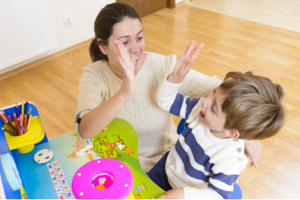 Validation is one of the most powerful parenting tools, and yet it is often left out of traditional behavioral parent training programs. In general, behavioral parent training programs focus on teaching parents to use positive attending skills, active ignoring for minor misbehaviors and limit setting in a clear and consistent way. While these skills do significantly improve the quality of relationships in the home and help children listen better, they focus less on bolstering emotion regulation skills in children.
Validation is one of the most powerful parenting tools, and yet it is often left out of traditional behavioral parent training programs. In general, behavioral parent training programs focus on teaching parents to use positive attending skills, active ignoring for minor misbehaviors and limit setting in a clear and consistent way. While these skills do significantly improve the quality of relationships in the home and help children listen better, they focus less on bolstering emotion regulation skills in children.
A child’s ability to regulate emotions affects relationships with family and peers, academic achievement, long-term mental health and future success. Parents seeking treatment for behavioral problems often report that their child is overly sensitive or has big emotional reactions compared to siblings or same-aged peers. Indeed, many clinical disorders in children, such as Attention Deficit/Hyperactivity Disorder (ADHD) and Oppositional Defiant Disorder (ODD), are associated with having more intense emotions and significant difficulty regulating those emotions. Children who experience emotion dysregulation are at increased risk of further mental health problems, including anxiety or depression.
By validating the emotional experience of children, parents can help them learn how to handle the big emotions that often lead to tantrums, meltdowns, and conflict within the family. Helping children learn to self-regulate is one of the most important parenting tasks, as emotion regulation is a critical life skill that is predictive of positive outcomes.
What is validation?
Validation is defined by Oxford Languages as “recognition or affirmation that a person or their feelings or opinions are valid or worthwhile.” When we validate the feelings of others, we put ourselves in their shoes to understand their emotional experience and accept it as real. Validating your child’s feelings does not mean you condone or agree with the actions your child takes. It simply let’s your child know that you understand their feelings and that it’s ok to have those feelings. It gives your child space to express their emotions nonjudgmentally, safely and without ignoring or pushing away those feelings.
How does validation help?
Validation helps de-escalate emotionally-charged situations, while allowing your child to feel heard, understood and accepted. When children are validated, they experience a reduction in the intensity of their emotions. Reducing the intensity of the emotion allows them to move through the meltdown faster and it opens your child up to problem solving or pushing through a difficult situation or task. Your child is better able to decide what to do next, rather than letting the emotion drive the behavioral response.
Validation teaches children to effectively label their own emotions and be more in tune with their body, thereby increasing emotional intelligence. When children can say, “I’m feeling angry” or “I’m so frustrated,” they are better able to effectively communicate their internal experience to the people around them, rather than lashing out with words, acting aggressively or having a tantrum. When they are able to communicate their feelings in this way, the adults around them are more likely to remain calm and offer help. This allows children to feel more accepted and supported, which strengthens relationships and promotes healthy self-esteem and self-worth.
Validation helps children develop frustration tolerance. Many children can become frustrated when working on a difficult or tricky task. When you validate how hard it is, and praise your child for sticking with it, they are more likely to persist.
Lastly, validating children helps them feel more compassion and empathy towards others, which can enhance the quality of their relationships with others.
How we inadvertently invalidate our children
It’s also important to understand how parents inadvertently invalidate their children. Invalidation is when a child’s emotional experience is rejected, judged or ignored. Every parent has unintentionally invalidated the feelings of their child. Many of the things that children get upset about seem trivial to adults or the emotions can seem disproportionate to the situation. It can be hard for an adult to put themselves in a child’s shoes at times.
Parents unintentionally invalidate their children when trying to help calm them. It can be hard to see your child suffering and struggling. Parents sometimes swoop in to reassure their children that everything will be ok. Parents are also too quick to jump to problem solving or suggest a coping strategy. At times, parents want to push the difficult feelings away because it’s hard to tolerate seeing their child in distress. Validation isn’t about fixing problems for our children or trying to change their emotional experience. It’s about allowing your child to sit with their emotion and acknowledge it.
Sometimes children are punished for their emotions or told they are an overreaction. Parents may tell their child to “just calm down,” which only serves to get them even more worked up. Dismissing a child’s emotions as “no reason to be angry” or saying, “you’re acting like a baby,” can make a child feel judged or rejected for their emotional experience, something they often have little control over. When a child is told that their internal emotional experience is wrong over and over, it makes them feel more out of control and less trusting of their own internal experience, which can have lasting negative impacts. It can also damage the relationship between a child and parent.
How can I validate my child?
Validating the emotions of your child can be difficult at times. Often a child’s distress brings on parent distress, and it can be hard to react calmly in the moment. It can also be difficult to ignore the behavioral response of your child. This is especially true when a child is engaging in aggressive or destructive behavior, and in this situation securing safety takes priority. Validation can happen once safety is restored.
Parents can try to validate their child anytime there is a strong emotional reaction to a situation or stimuli. Being present with your child shows them that you support them and their emotions aren’t too big for you to handle. Sitting calmly nearby let’s your child know that you are there and ready to help when they are calm and able to move on. It also models staying calm in difficult situations.
Reflecting back their thoughts or feelings is another way to validate. For example, “It sounds like you were frustrated when your brother knocked your blocks down. I know you worked very hard on building it up.” When children are less able to express their thoughts or feelings, it’s ok for parents to try to guess what they might be feeling. You might say, “I’m guessing your feeling disappointed right now.” It’s also ok to be wrong. It still shows that you are there and trying to understand.
Another way to validate your child is by normalizing their feelings. It can be helpful for children to know they’re not alone and that others would feel the same way. Saying something like, “of course your anxious about starting a new school – everyone feels nervous when starting something new.” Just be sure not to immediately jump in with reassurance at this point. Instead you may say, “it’s ok to feel nervous.”
Validate all feelings even if you don’t agree with the reaction. Try to ignore the behavior and focus only on the emotion. Once your child is calmer, praise their coping or pushing through. For example, “I know that was really hard for you. You were getting very frustrated. I’m proud of you for sticking with it.” Try to anticipate situations that may lead to big emotions and think about how you can validate your child should emotions intensify.
Lastly, don’t forget to validate yourself and model positive coping skills. Kids learn a lot about how to deal with emotions by watching how the adults around them respond to their own emotions. Saying, “I am feeling very frustrated. It makes sense I feel this way, this is tricky. I’m going to take a break and come back to this when I’m calmer.” This models acceptance of emotions, as well as healthy coping, and can go along way in helping children develop emotion regulation skills.





